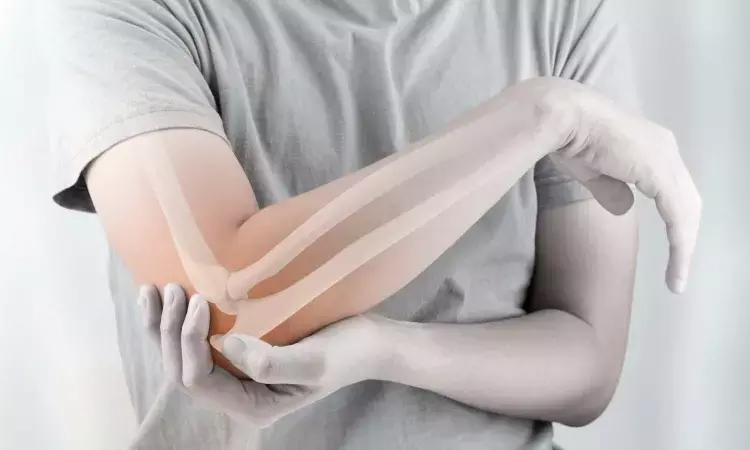- Home
- Medical news & Guidelines
- Anesthesiology
- Cardiology and CTVS
- Critical Care
- Dentistry
- Dermatology
- Diabetes and Endocrinology
- ENT
- Gastroenterology
- Medicine
- Nephrology
- Neurology
- Obstretics-Gynaecology
- Oncology
- Ophthalmology
- Orthopaedics
- Pediatrics-Neonatology
- Psychiatry
- Pulmonology
- Radiology
- Surgery
- Urology
- Laboratory Medicine
- Diet
- Nursing
- Paramedical
- Physiotherapy
- Health news
- Fact Check
- Bone Health Fact Check
- Brain Health Fact Check
- Cancer Related Fact Check
- Child Care Fact Check
- Dental and oral health fact check
- Diabetes and metabolic health fact check
- Diet and Nutrition Fact Check
- Eye and ENT Care Fact Check
- Fitness fact check
- Gut health fact check
- Heart health fact check
- Kidney health fact check
- Medical education fact check
- Men's health fact check
- Respiratory fact check
- Skin and hair care fact check
- Vaccine and Immunization fact check
- Women's health fact check
- AYUSH
- State News
- Andaman and Nicobar Islands
- Andhra Pradesh
- Arunachal Pradesh
- Assam
- Bihar
- Chandigarh
- Chattisgarh
- Dadra and Nagar Haveli
- Daman and Diu
- Delhi
- Goa
- Gujarat
- Haryana
- Himachal Pradesh
- Jammu & Kashmir
- Jharkhand
- Karnataka
- Kerala
- Ladakh
- Lakshadweep
- Madhya Pradesh
- Maharashtra
- Manipur
- Meghalaya
- Mizoram
- Nagaland
- Odisha
- Puducherry
- Punjab
- Rajasthan
- Sikkim
- Tamil Nadu
- Telangana
- Tripura
- Uttar Pradesh
- Uttrakhand
- West Bengal
- Medical Education
- Industry
Ultrasonography useful modality for Forearm fracture diagnosis in children: NEJM

A new study published in the New England journal of Medicine suggests that with regard to the result of physical function of the arm at 4 weeks, the use of ultrasonography as the initial diagnostic imaging tool in children and adolescents with a distal forearm injury was noninferior to radiography.
There is minimal information on whether radiography or ultrasonography is non-inferior for the first diagnostic imaging of forearm fractures in children and adolescents. Therefore, Peter Snelling and colleagues undertook this study to evaluate the effectiveness of ultrasonography for diagnostic imaging in fractures.
Participants aged 5 to 15 who presented to the emergency room with an isolated distal forearm injury without a clinically obvious deformity and for whom further imaging evaluation was indicated were recruited for this open-label, non-inferiority, multicenter, randomized trial in Australia. Participants were given a random choice between point-of-care radiography or ultrasonography, and they were then monitored for eight weeks after that. The validated Paediatric Upper Extremity Short Patient-Reported Outcomes Measurement Information System (PROMIS) score was used to evaluate the physical function of the affected arm at 4 weeks; a non-inferiority margin of 5 points was used. Higher scores indicate better function.
The key findings of this study were:
A total of 270 individuals were enrolled, with outcomes for 262 of them (97%) accessible after 4 weeks (with a 3-day interval) as planned.
At 4 weeks, PROMIS scores in the ultrasonography group were comparable to those in the imaging group (mean, 36.4 and 36.3 points, correspondingly; mean difference, 0.1 point; 95% confidence interval [CI], 1.3 to 1.4).
Intention-to-treat analyses found comparable results (mean difference, 0.1 point; 95% CI, 1.3 to 1.4) in 266 participants with primary outcome data obtained at any time.
There were no clinically significant fractures missed, and there were no differences in the prevalence of adverse events across groups.
Reference:
Snelling, P. J., Jones, P., Bade, D., Bindra, R., Byrnes, J., Davison, M., George, S., Moore, M., Keijzers, G., & Ware, R. S. (2023). Ultrasonography or Radiography for Suspected Pediatric Distal Forearm Fractures. In New England Journal of Medicine (Vol. 388, Issue 22, pp. 2049–2057). Massachusetts Medical Society. https://doi.org/10.1056/nejmoa2213883
Neuroscience Masters graduate
Jacinthlyn Sylvia, a Neuroscience Master's graduate from Chennai has worked extensively in deciphering the neurobiology of cognition and motor control in aging. She also has spread-out exposure to Neurosurgery from her Bachelor’s. She is currently involved in active Neuro-Oncology research. She is an upcoming neuroscientist with a fiery passion for writing. Her news cover at Medical Dialogues feature recent discoveries and updates from the healthcare and biomedical research fields. She can be reached at editorial@medicaldialogues.in
Dr Kamal Kant Kohli-MBBS, DTCD- a chest specialist with more than 30 years of practice and a flair for writing clinical articles, Dr Kamal Kant Kohli joined Medical Dialogues as a Chief Editor of Medical News. Besides writing articles, as an editor, he proofreads and verifies all the medical content published on Medical Dialogues including those coming from journals, studies,medical conferences,guidelines etc. Email: drkohli@medicaldialogues.in. Contact no. 011-43720751


